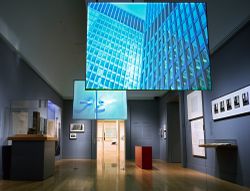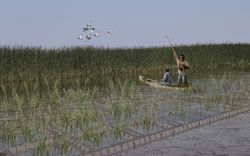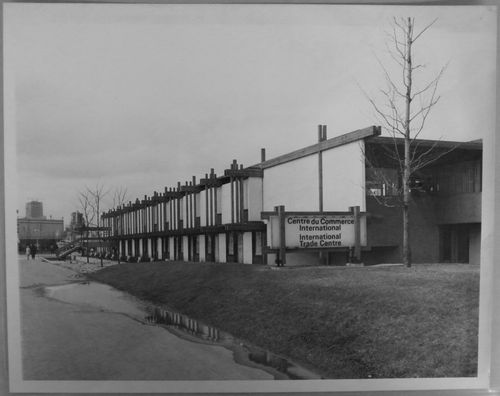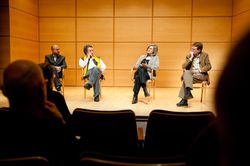Mies in America
A profound thinker, painstaking artist, and one of the greatest architects in history, Ludwig Mies van der Rohe emigrated from Germany to the United States in 1938, when he was already in his fifties and one of the recognized masters of his profession. Transplanted from the Bauhaus (of which he was the last director) to a technical institute in Chicago, from the European(...)
Main galleries
17 October 2001 to 20 January 2002
Mies in America
Actions:
Description:
A profound thinker, painstaking artist, and one of the greatest architects in history, Ludwig Mies van der Rohe emigrated from Germany to the United States in 1938, when he was already in his fifties and one of the recognized masters of his profession. Transplanted from the Bauhaus (of which he was the last director) to a technical institute in Chicago, from the European(...)
Main galleries
The St. Peter’s Indian Band (now Peguis First Nation) was forcibly removed from their original lands at Netley-Libau Marsh beginning in 1908, after an illegal surrender vote took place. Since then, the health of the area that was once the Peguis’s home has declined due to intense annual flooding and ice jams; the appearance of invasive species such as purple loosestrife,(...)
online Keyword(s):
Indigenous-led design, fellow, Peguis First Nation, land rehabilitation
27 April 2023, 6:00 to 7:30 p.m.
Peguis First Nation and the Netley-Libau Marsh: Documenting Indigenous Land Use and Occupancy at the Mouth of Lake Winnipeg
Actions:
Description:
The St. Peter’s Indian Band (now Peguis First Nation) was forcibly removed from their original lands at Netley-Libau Marsh beginning in 1908, after an illegal surrender vote took place. Since then, the health of the area that was once the Peguis’s home has declined due to intense annual flooding and ice jams; the appearance of invasive species such as purple loosestrife,(...)
online Keyword(s):
Indigenous-led design, fellow, Peguis First Nation, land rehabilitation
ARCH256085
Description:
"Le Centre du Commerce international à l'Expo 67 / Ce pavillon, commandité par les banques à charte du Canada dont chacune y tient son propre bureau, est doté d'un grand bar-salon où se déroulent les principales activités de l'Expo-club, lieu de rencontre des hommes d'affaires canadiens et étrangers. / The International Trade Centre at Expo 67 / This pavilion, which houses the Business Development Bureau, was sponsored by the Chartered Banks of Canada. It is designed to afford businessmen of the world an opportunity to meet their Canadian counterparts. Each of the Chartered Banks have offices in the building, which also provides Expo club, a meeting place for Canadian and world businessmen."--Description.
1967
View of the International Trade Centre, Expo 67, Montréal, Québec
Actions:
ARCH256085
Description:
"Le Centre du Commerce international à l'Expo 67 / Ce pavillon, commandité par les banques à charte du Canada dont chacune y tient son propre bureau, est doté d'un grand bar-salon où se déroulent les principales activités de l'Expo-club, lieu de rencontre des hommes d'affaires canadiens et étrangers. / The International Trade Centre at Expo 67 / This pavilion, which houses the Business Development Bureau, was sponsored by the Chartered Banks of Canada. It is designed to afford businessmen of the world an opportunity to meet their Canadian counterparts. Each of the Chartered Banks have offices in the building, which also provides Expo club, a meeting place for Canadian and world businessmen."--Description.
archives
Level of archival description:
Fonds
Roger D’Astous fonds
AP060
Synopsis:
Le fonds témoigne des activités personnelles et professionnelles de Roger D'Astous, de sa carrière d'architecte et de sa contribution à l'architecture québécoise. Il nous renseigne sur sa formation académique à l'École des Beaux-Arts de Montréal, sur son séjour en tant qu'apprenti à l'atelier de Frank Lloyd Wright à Taliesin (Arizona et Wisconsin), ainsi que sur sa pratique professionnelle en tant qu'architecte. Ces projets professionnels sont principalement concentrés au Québec, à Montréal, en Montérégie, dans les Laurentides, à Laval, ainsi qu'en Ontario (dont à Brockville et à Kingston). Le fonds contient, entre autres, 4 100 dessins d’architecture, 2 581 documents photographiques, 7 maquettes et 1,23 m.l. de documents textuels.
1893-1998, surtout 1951-1998
Roger D’Astous fonds
Actions:
AP060
Synopsis:
Le fonds témoigne des activités personnelles et professionnelles de Roger D'Astous, de sa carrière d'architecte et de sa contribution à l'architecture québécoise. Il nous renseigne sur sa formation académique à l'École des Beaux-Arts de Montréal, sur son séjour en tant qu'apprenti à l'atelier de Frank Lloyd Wright à Taliesin (Arizona et Wisconsin), ainsi que sur sa pratique professionnelle en tant qu'architecte. Ces projets professionnels sont principalement concentrés au Québec, à Montréal, en Montérégie, dans les Laurentides, à Laval, ainsi qu'en Ontario (dont à Brockville et à Kingston). Le fonds contient, entre autres, 4 100 dessins d’architecture, 2 581 documents photographiques, 7 maquettes et 1,23 m.l. de documents textuels.
archives
Level of archival description:
Fonds
1893-1998, surtout 1951-1998
archives
Level of archival description:
Fonds
Alessandro Poli fonds
AP148
Synopsis:
The Alessandro Poli fonds documents the work of Italian architect, designer and artist Alessandro Poli. Born in Fiesole in 1941, Poli studied architecture at the University of Florence, and was a member of Superstudio from 1970 to 1972. Poli’s involvement with Superstudio and engaged research on material culture constitute two strong components of his archive.
1963-1996
Alessandro Poli fonds
Actions:
AP148
Synopsis:
The Alessandro Poli fonds documents the work of Italian architect, designer and artist Alessandro Poli. Born in Fiesole in 1941, Poli studied architecture at the University of Florence, and was a member of Superstudio from 1970 to 1972. Poli’s involvement with Superstudio and engaged research on material culture constitute two strong components of his archive.
archives
Level of archival description:
Fonds
1963-1996
archives
Level of archival description:
Fonds
Pierlucio Pellissier fonds
AP215
Synopsis:
Le fonds Pierlucio Pellissier, 1946-2020, documente les projets de conservation et de commissariat entrepris par Pierlucio Pellissier, architecte, conservateur et professeur, entre 1996 et 2003. Le fonds comprend des documents textuels et photographiques touchant à trois projets distincts : les restaurations de deux églises décorées par l’architecte et artiste Guido Nincheri (1885-1973), qui en assura également le design architectural, soit Sainte-Amélie à Baie-Comeau, Québec (1938-1939) et Notre-Dame-de-la-Défense, Montréal (1919), et le commissariat d’une exposition sur l’œuvre de Guido Nincheri tenue à Montréal en 2001. Le travail de conservation et de restauration des fresques de Nincheri, qui ornent les deux églises, forme la plus grande partie de la documentation, mettant en lumière la spécificité du médium et les problématiques de la conservation d’œuvres d’art à portée publique.
1946-2020
Pierlucio Pellissier fonds
Actions:
AP215
Synopsis:
Le fonds Pierlucio Pellissier, 1946-2020, documente les projets de conservation et de commissariat entrepris par Pierlucio Pellissier, architecte, conservateur et professeur, entre 1996 et 2003. Le fonds comprend des documents textuels et photographiques touchant à trois projets distincts : les restaurations de deux églises décorées par l’architecte et artiste Guido Nincheri (1885-1973), qui en assura également le design architectural, soit Sainte-Amélie à Baie-Comeau, Québec (1938-1939) et Notre-Dame-de-la-Défense, Montréal (1919), et le commissariat d’une exposition sur l’œuvre de Guido Nincheri tenue à Montréal en 2001. Le travail de conservation et de restauration des fresques de Nincheri, qui ornent les deux églises, forme la plus grande partie de la documentation, mettant en lumière la spécificité du médium et les problématiques de la conservation d’œuvres d’art à portée publique.
archives
Level of archival description:
Fonds
1946-2020
archives
Level of archival description:
Fonds
Ernest Cormier fonds
AP001
Synopsis:
Le Fonds Ernest Cormier documente la vie personnelle, artistique et professionnelle d'Ernest Cormier. Le fonds compte près de 30 000 dessins et reproductions ainsi que les dossier administratif relatifs à plus de 110 projets architecturaux réalisés par Cormier entre 1919 et 1964, environ 14 000 documents photographiques, incluant les photographies par Ernest Cormier, sa correspondance et documents personnels, ses oeuvres d'arts, et de nombreux outils et objets utilisés par Cormier pour ses projets artistiques et architecturaux.
1857-1980
Ernest Cormier fonds
Actions:
AP001
Synopsis:
Le Fonds Ernest Cormier documente la vie personnelle, artistique et professionnelle d'Ernest Cormier. Le fonds compte près de 30 000 dessins et reproductions ainsi que les dossier administratif relatifs à plus de 110 projets architecturaux réalisés par Cormier entre 1919 et 1964, environ 14 000 documents photographiques, incluant les photographies par Ernest Cormier, sa correspondance et documents personnels, ses oeuvres d'arts, et de nombreux outils et objets utilisés par Cormier pour ses projets artistiques et architecturaux.
archives
Level of archival description:
Fonds
1857-1980
Curatorial practice as it emerged during the twentieth century is no doubt being extensively recast. The tremendous change in the status of the object, of culture, of the various disciplines, or information and education, implies an inevitable transformation of the curator’s role and competences. A renewed interest for curatorial practice has emerged within the field of(...)
Paul Desmarais Theatre
11 November 2010 to 13 November 2010
The CCA in an Expanding Curatorial Field
Actions:
Description:
Curatorial practice as it emerged during the twentieth century is no doubt being extensively recast. The tremendous change in the status of the object, of culture, of the various disciplines, or information and education, implies an inevitable transformation of the curator’s role and competences. A renewed interest for curatorial practice has emerged within the field of(...)
Paul Desmarais Theatre
archives
Level of archival description:
Fonds
Douglas Kelbaugh fonds
AP153
Synopsis:
The Douglas Kelbaugh fonds documents the professional practice of architect Douglas Kelbaugh from the beginning of his carreer in 1973, his partnership in the Kelbaugh + Lee Architects firm, in 1978, to his late projects in the 1990s. The documents in the fonds consist of drawings, textual records, photographs and panels relating to over 20 projects, predominantly his work in sustainable architecture in the United States from the early 1970s to the mid 1990s.
1970-2008
Douglas Kelbaugh fonds
Actions:
AP153
Synopsis:
The Douglas Kelbaugh fonds documents the professional practice of architect Douglas Kelbaugh from the beginning of his carreer in 1973, his partnership in the Kelbaugh + Lee Architects firm, in 1978, to his late projects in the 1990s. The documents in the fonds consist of drawings, textual records, photographs and panels relating to over 20 projects, predominantly his work in sustainable architecture in the United States from the early 1970s to the mid 1990s.
archives
Level of archival description:
Fonds
1970-2008
archives
Level of archival description:
Fonds
Hazen Sise fonds
AP112
Synopsis:
The Hazen Sise fonds contains negatives, drawings, and other documents dating from 1933 to 1959. The negatives, taken in the early 1930s, mostly depict participants of the conferences CIAM IV and CIRPAC, including Le Corbusier, László Moholy-Nagy, Alvar Aalto and Fernand Léger. The drawings document the design of Beaver Lake Pavilion, built for the City of Montréal between 1955 and 1959 as part of the redevelopment of Mount Royal Park. Le fonds Hazen Sise est composé de négatifs, dessins, et autres documents datés entre 1933 et 1959. Les négatifs, pris au début des années 30s, présentent des participants des congres IVe CIAM et CIRPAC, incluant Le Corbusier, László Moholy-Nagy, Alvar Aalto et Fernand Léger. Les dessins documentent la conception du pavillon du Lac aux Castors, construit pour la Ville de Montréal entre 1955 et 1959 dans le cadre du réaménagement du Parc du Mont-Royal.
1933-1959
Hazen Sise fonds
Actions:
AP112
Synopsis:
The Hazen Sise fonds contains negatives, drawings, and other documents dating from 1933 to 1959. The negatives, taken in the early 1930s, mostly depict participants of the conferences CIAM IV and CIRPAC, including Le Corbusier, László Moholy-Nagy, Alvar Aalto and Fernand Léger. The drawings document the design of Beaver Lake Pavilion, built for the City of Montréal between 1955 and 1959 as part of the redevelopment of Mount Royal Park. Le fonds Hazen Sise est composé de négatifs, dessins, et autres documents datés entre 1933 et 1959. Les négatifs, pris au début des années 30s, présentent des participants des congres IVe CIAM et CIRPAC, incluant Le Corbusier, László Moholy-Nagy, Alvar Aalto et Fernand Léger. Les dessins documentent la conception du pavillon du Lac aux Castors, construit pour la Ville de Montréal entre 1955 et 1959 dans le cadre du réaménagement du Parc du Mont-Royal.
archives
Level of archival description:
Fonds
1933-1959



